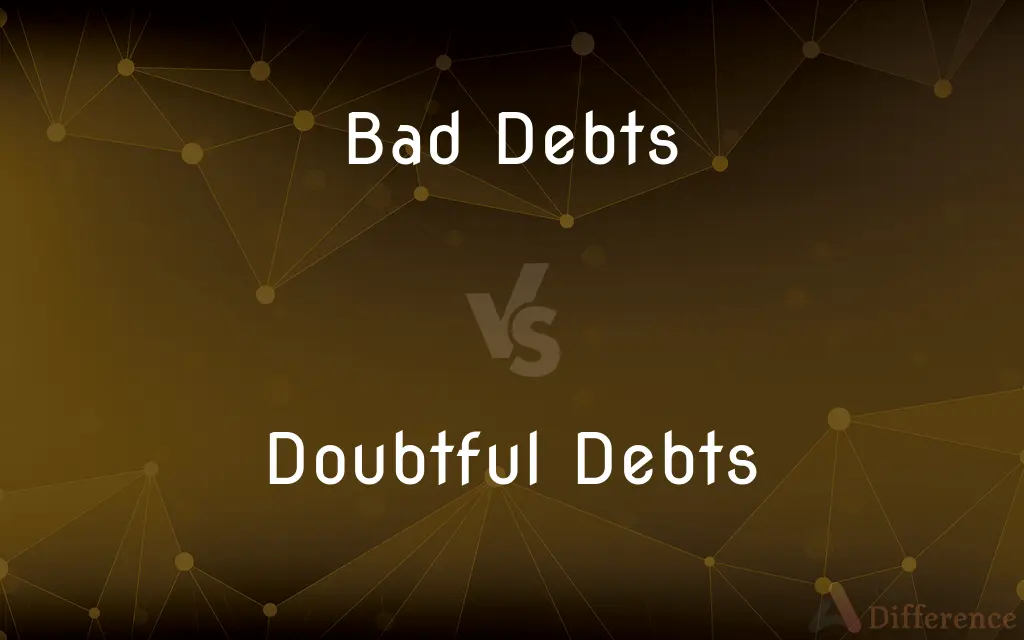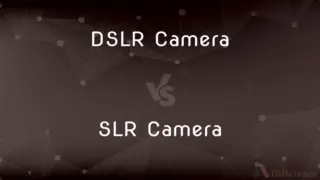Bad Debts vs. Doubtful Debts — What's the Difference?
By Tayyaba Rehman — Published on December 22, 2023
Bad Debts are uncollectible accounts; Doubtful Debts are potentially uncollectible.

Difference Between Bad Debts and Doubtful Debts
Table of Contents
ADVERTISEMENT
Key Differences
Bad Debts refer to amounts which are confirmed to be uncollectible. After all efforts have been made to recover the money and it's concluded that repayment is unlikely, the amount is written off as Bad Debts. On the other hand, Doubtful Debts are those amounts which are suspected to become uncollectible, but there is still a possibility of collection. Essentially, Doubtful Debts represent uncertainty in collection.
While Bad Debts denote finality, signifying that a business has accepted a loss, Doubtful Debts linger in a gray area. A business with Doubtful Debts hopes to recover the money but acknowledges the risk involved. Both Bad Debts and Doubtful Debts are crucial for financial reporting, ensuring that companies don't overstate their assets.
From an accounting perspective, Bad Debts result in a direct reduction from accounts receivable. They've been deemed lost for good. Doubtful Debts, conversely, don't immediately impact accounts receivable. Instead, a provision or allowance for Doubtful Debts is created, serving as a cushion against potential future losses.
Both Bad Debts and Doubtful Debts have tax implications. For instance, businesses can typically write off Bad Debts as an expense, reducing their taxable income. However, Doubtful Debts cannot be claimed as an expense until they are reclassified as Bad Debts. Both terms, therefore, hold significance in tax planning and financial strategy.
Comparison Chart
Definition
Confirmed uncollectible amounts.
Potentially uncollectible amounts.
ADVERTISEMENT
Impact on Financials
Directly reduces accounts receivable.
Leads to a provision or allowance.
Certainty
Absolute certainty of non-recovery.
Uncertainty exists.
Tax Implication
Can be written off as an expense.
Can't be claimed until classified as Bad Debts.
Treatment
Written off after recovery deemed impossible.
Recognized as a potential future loss.
Compare with Definitions
Bad Debts
Financial losses from uncollectible accounts.
To maintain accuracy, businesses must account for Bad Debts in their books.
Doubtful Debts
Amounts where collection is uncertain.
We classify long-pending invoices as Doubtful Debts to reflect potential risks.
Bad Debts
Amounts known to be uncollectible.
After months of trying, the company wrote off $2,000 as Bad Debts.
Doubtful Debts
Financial cushions against possible non-recoveries.
The accountant suggested raising the provision for Doubtful Debts given market trends.
Bad Debts
Accounts receivable that won't be recovered.
Our Bad Debts rose significantly due to the recent economic downturn.
Doubtful Debts
Uncertain collectibility from certain customers.
Economic uncertainties have elevated our Doubtful Debts this year.
Bad Debts
Confirmed losses due to non-payment.
The financial report showed an increase in Bad Debts this quarter.
Doubtful Debts
Amounts suspected to be uncollectible.
The company set aside $5,000 as Doubtful Debts considering the debtor's financial instability.
Bad Debts
Definite uncollectible amounts from debtors.
Amid the crisis, many businesses faced a surge in Bad Debts.
Doubtful Debts
Potential non-payment risks in accounts receivable.
Increasing Doubtful Debts indicates a need for better credit policies.
Common Curiosities
Why are Doubtful Debts significant for businesses?
Doubtful Debts help businesses anticipate and prepare for potential losses in revenue.
What distinguishes Doubtful Debts from Bad Debts?
Doubtful Debts are amounts suspected to be uncollectible, whereas Bad Debts are confirmed uncollectible amounts.
Can businesses claim Doubtful Debts as a tax expense?
No, Doubtful Debts can't be claimed until they're classified as Bad Debts.
What's the financial impact of Doubtful Debts?
Doubtful Debts lead to a provision or allowance in the financial statements, serving as a buffer against potential losses.
How do companies handle Bad Debts in accounting?
Bad Debts are written off, resulting in a direct reduction from accounts receivable.
When should a company recognize Doubtful Debts?
When there's uncertainty about collecting certain amounts, but it's not yet confirmed as a loss.
What are Bad Debts?
Bad Debts are amounts deemed uncollectible after all recovery efforts have been exhausted.
Can Doubtful Debts become Bad Debts?
Yes, if it's later determined that the Doubtful Debts are uncollectible, they're reclassified as Bad Debts.
Are Doubtful Debts and Bad Debts the same?
No, Doubtful Debts represent potential losses, while Bad Debts are confirmed losses.
How do Bad Debts impact a company's profitability?
Bad Debts reduce profits as they represent amounts that won't be recovered.
How often should companies review their Bad Debts?
Regularly, to ensure financial statements accurately reflect the company's financial health.
Why do companies maintain a provision for Doubtful Debts?
To anticipate potential non-recoveries and present a realistic view of the accounts receivable.
Can Bad Debts be reversed?
Rarely. If an amount previously written off as Bad Debts is later collected, it can be reversed.
How can businesses minimize Bad Debts?
By implementing strict credit policies, regularly reviewing accounts receivable, and promptly following up on overdue payments.
Do all businesses face Bad Debts?
Most businesses face Bad Debts at some point, especially if they offer credit to customers.
Share Your Discovery

Previous Comparison
DSLR Camera vs. SLR Camera
Next Comparison
Bowman’s Capsule vs. Malpighian CapsuleAuthor Spotlight
Written by
Tayyaba RehmanTayyaba Rehman is a distinguished writer, currently serving as a primary contributor to askdifference.com. As a researcher in semantics and etymology, Tayyaba's passion for the complexity of languages and their distinctions has found a perfect home on the platform. Tayyaba delves into the intricacies of language, distinguishing between commonly confused words and phrases, thereby providing clarity for readers worldwide.













































